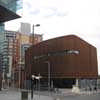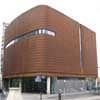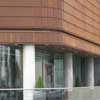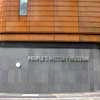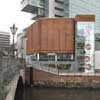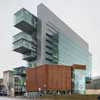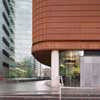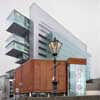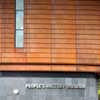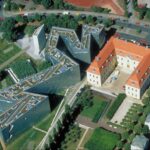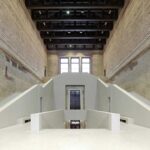People’s History Museum, Manchester Building, Project, Photo, News, Design, Property, Image
People’s History Museum Manchester
Spinningfields Building, northwest England, UK – design by Austin-Smith:Lord, architects
9 Mar 2010
People’s History Museum
Architects: Austin-Smith:Lord
Address: Left Bank, Spinningfields, Manchester, Lancashire
Location: on River Irwell, west of Deansgate, west side of city centre
Contact: 0161 838 9190
People’s History Museum Manchester photos © Adrian Welch, Apr 2010:
The People’s History Museum focuses on an internationally important collection which includes the Labour Party archive, along with collections of the Trades Union Congress, Communist party of Great Britain, Suffragists and Suffragettes and the co-operative movement. The museum has one of the largest and most important banner collections in the world supported by in-house textile conservation expertise.
The museum’s charter is to “explore the world changing events led by the working people of Britain” and this is achieved through, “collecting, conserving and safe guarding archives and the material culture of working people and their organisations” and “interpreting the collection for the education and entertainment of as many people as possible through galleries, temporary exhibitions and events programmes and an education service for children and adults.”
People’s History Museum photos : Ian Lawson
People’s History Museum Manchester – The Project
In January 2004 Austin-Smith:Lord were appointed to lead a multi-disciplinary design team to explore the possibilities for consolidation of the People’s History Museum’s two operational sites in Manchester into one location through an expansion of the existing Pump House Museum.
Occupying the only one of three Edwardian hydraulic power stations to survive in the city, the Pump House is situated to the north west of the city centre, bordered by the River Irwell, Bridge Street West and the new multi-storey Civil Justice Centre on Gartside Street.
This area forms the northern tip of the extensive redevelopment area in the city known as ‘Spinningfields’. This is an area of the city that has undergone a significant change of scale and importance which over the last few years has created over 2.5m sq.ft. of new commercial, retail and residential space.
The availability of an area of city council owned land adjacent to the Pump House provided the opportunity for consolidating all the museum’s public facing activities onto one site through the provision of a new extension which would allow the expansion of permanent galleries and new 21st century facilities for the public.
The site benefitted from a prominent riverside location at the Manchester/Salford border and, afforded space by both the river and the public piazza in front of the new Civil Justice Centre, had the potential for a dramatic ‘object’ building which could significantly improve the Museum’s presence in this key new area of the city.
The Museum, which re-opened in February 2010, has been completely refurbished and extended to provide a fitting new home for a unique and nationally important collection.
The new extension takes the form of a five-storey building, built into the site’s sloping, riverbank location and the site’s potential has been exploited by a bold and dramatic new presence on this important city centre artery and gateway location.
The fully glazed ground floor concourse is welcoming, allows deep views across the building and provides activity and interest at street level, an impression reinforced by a café terrace overlooking the river.
It provides a generous space for new café, bar and dining facilities along with a new shop, reception and toilet facilities and most importantly encourages access along the concourse towards the original Pump House building.
Two levels of climate controlled permanent galleries are provided at high level, accessed by a new lift and stair tower that celebrates the museum’s waterside setting. The top floor provides a large Conservation Studio for banners and textiles. A lower level, facing onto a riverside walkway accommodates a new archive (to BS5454:2000 standards) and a new Reading Room with river views.
In developing a masterplan for the expanded museum the successful balance of use between new and old buildings was a key aim. Providing the majority of close conditioned space and visitor facilities in the new extension has allowed the sensitive restoration of the key spaces within the historic building.
The Engine Hall has been stripped of its original shop and café intrusions to recover its dramatic volume and will now provide a multi-purpose space for daylight tolerant exhibitions, education and conference events.
A new expanded changing exhibition gallery has been provided at ground floor level, which can be linked flexibly with the Engine Hall and this has allowed the original form of the first floor ‘coal store’ to be recovered and used as a conference facility.
The basement of the Pump House has been converted from gallery use to provide offices and the big windows to the river have been opened up to flood this space with daylight again. The need for close controlled, light-proof galleries has been exploited visually to mark the refurbished museum’s presence through strong sculptural form-making.
The extension is unmistakably a new building yet it establishes a sympathetic relationship with the maturity of the Pump House through the tonality of the Cor-ten rainscreen cladding and the simple ‘tank-like’ massing.
The design has achieved prominence without overbearing the original Pump House building, the transparency and ‘connectivity’ of the new entrance sequence ensures that the existing building is not marginalised, a dramatic high level bridge within the linking section of the building encourages a ‘promenade’ between new and old.
People’s History Museum Manchester images / information from Austin-Smith:Lord
Location: Gartside Street, Manchester, Northwest England, UK
Manchester Buildings
Contemporary Manchester Architecture
Manchester Architecture Walking Tours
Manchester Town Hall Project
Manchester Town Hall Redevelopment
Old Trafford Ground
Old Trafford Cricket Ground
Beetham Tower – Tallest residential tower in Europe
Design: Ian Simpson Architects
Manchester Hilton
Manchester Civil Justice Centre
Manchester Buildings Photographs
Comments / photos for the People’s History Museum Manchester Architecture page welcome
Website: www.phm.org.uk

